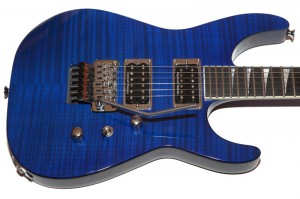 If you’ve read my article entitled A Tale of Two Jacksons, you’ll see that I own both a Japanese SL2H in transparent blue, and a USA Jackson SL2H in transparent blue. While the USA Jackson SL2H is the superior guitar, I really disliked the chrome hardware and set out to replace every bit of chrome with black. For the uninitiated, this was not a small task.
If you’ve read my article entitled A Tale of Two Jacksons, you’ll see that I own both a Japanese SL2H in transparent blue, and a USA Jackson SL2H in transparent blue. While the USA Jackson SL2H is the superior guitar, I really disliked the chrome hardware and set out to replace every bit of chrome with black. For the uninitiated, this was not a small task.
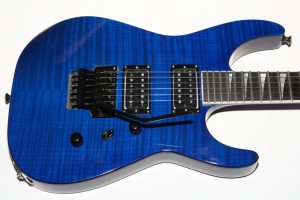 USA Jacksons come with high quality components. For example the pickup rings are metal, the Floyd Rose is the real deal and even the switch tip is a sexy metal work of art. For a guitar of this caliber, I resolved to replace each component with the same item, or if possible, an even better version. I wanted to keep the overall feel of the guitar the same, but just replace the shiny chrome with black. I also decided to install a push-pull coil-tap into the guitar to add some versatility.
USA Jacksons come with high quality components. For example the pickup rings are metal, the Floyd Rose is the real deal and even the switch tip is a sexy metal work of art. For a guitar of this caliber, I resolved to replace each component with the same item, or if possible, an even better version. I wanted to keep the overall feel of the guitar the same, but just replace the shiny chrome with black. I also decided to install a push-pull coil-tap into the guitar to add some versatility.
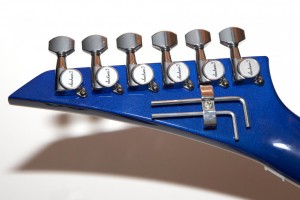 The first thing I had to do was source the parts. It’s not easy to find real Jackson parts, and my first roadblock was the Jackson-branded Gotoh tuners. I knew that I could buy plain old Gotoh tuners, but I wanted them to match, mostly because I’m admittedly nuts and I wouldn’t be able to sleep at night if my Jackson didn’t have tuners that said Jackson on them.
The first thing I had to do was source the parts. It’s not easy to find real Jackson parts, and my first roadblock was the Jackson-branded Gotoh tuners. I knew that I could buy plain old Gotoh tuners, but I wanted them to match, mostly because I’m admittedly nuts and I wouldn’t be able to sleep at night if my Jackson didn’t have tuners that said Jackson on them.
I asked around on the Jackson/Charvel forum (jcfonline.com) and was pointed to eBay member electricguitarparts who sold real Jackson parts. He had the tuners for the import models listed, but not for the USA model. They’re different. I’m anal. Get used to it. I emailed him and he told me that he had a set of the proper ones in stock. Score! First step done.
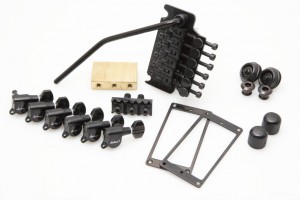 Next were the metal rings. I’d never seen metal rings before having a USA Jackson, and finding them proved to be another challenge. At the recommendation of the Jackson/Charvel forum again, I went to fretsonthenet.com. There I ordered a set of rings and a football jack plate for the output jack. They weren’t cheap, but they were the best, so I paid. Only problem was that I had to wait for them to be made. I hate to wait, but I ordered anyway.
Next were the metal rings. I’d never seen metal rings before having a USA Jackson, and finding them proved to be another challenge. At the recommendation of the Jackson/Charvel forum again, I went to fretsonthenet.com. There I ordered a set of rings and a football jack plate for the output jack. They weren’t cheap, but they were the best, so I paid. Only problem was that I had to wait for them to be made. I hate to wait, but I ordered anyway.
While searching for parts I came upon guitarelctronics.com. They had black metal rings that were only about $10 each. I ordered a pair to see if they were any good. They also had a black metal switch toggle. Another score. Happy with my progress I went in search of a real Floyd Rose.
A quick search determined that Warmoth.com sold real German-made Floyd rose bridges, so I put one in my cart. From my research I knew that I needed an R3 locking nut, so I chose that as well. I also found a set of pretty nice looking knobs that looked like they would do the job. Order placed, I moved on a nice upgraded block for my new Floyd Rose. Floydupgrades.com sells nice brass blocks to replace the cheap ones included with even the nicest of Floyds. I had put one in my import Jackson and loved it, so ordered one for this project as well.
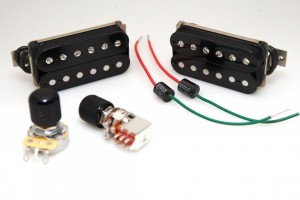 Finally I ordered new electronics and pickups. The Seymour Duncan pickups in the USA Jackson SL2H sounded much nicer than they did in my Japanese SL2H, but I despise companies advertising on the bobbins of my pickups. I took this opportunity to get a nice set of WCR pickups from Jim Wagner at wcrguitar.com. I had three sets of Jim’s pickups already, including an Ironman set in my Japanese SL2H. I wanted something a little more articulate this time and Jim recommended his American Steele set. I placed my order and decided to try his electronics too. To make things interesting, I included a push/pull pot so I could wire the pickups with a coil-tap. With all the ordering done, I set about my daily life trying not to think about all the toys coming in the mail. It was a long week.
Finally I ordered new electronics and pickups. The Seymour Duncan pickups in the USA Jackson SL2H sounded much nicer than they did in my Japanese SL2H, but I despise companies advertising on the bobbins of my pickups. I took this opportunity to get a nice set of WCR pickups from Jim Wagner at wcrguitar.com. I had three sets of Jim’s pickups already, including an Ironman set in my Japanese SL2H. I wanted something a little more articulate this time and Jim recommended his American Steele set. I placed my order and decided to try his electronics too. To make things interesting, I included a push/pull pot so I could wire the pickups with a coil-tap. With all the ordering done, I set about my daily life trying not to think about all the toys coming in the mail. It was a long week.
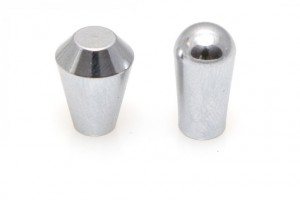 For those keeping track, I did not score a proper black Jackson switch tip, nor did I manage to find knobs that were a perfect match. Instead of replacing the strap pins with Jackson parts I put on a set of black Dunlop Straplocks. As of this writing, I have still not come up with a source for the Jackson switch tip knob. Why is this so troublesome? Anyone with a USA Jackson will know right away, but for those of you who have never seen nor felt one, check out the picture. On the left is the USA Jackson soloist switch tip. On the right is a very nice chrome Les Paul switch top. The Jackson switch tip is very cool and is just one of those things that makes a USA Jackson so desirable. Still, with everything finally delivered but the pickups and electronics, I was eager to make some cosmetic changes.
For those keeping track, I did not score a proper black Jackson switch tip, nor did I manage to find knobs that were a perfect match. Instead of replacing the strap pins with Jackson parts I put on a set of black Dunlop Straplocks. As of this writing, I have still not come up with a source for the Jackson switch tip knob. Why is this so troublesome? Anyone with a USA Jackson will know right away, but for those of you who have never seen nor felt one, check out the picture. On the left is the USA Jackson soloist switch tip. On the right is a very nice chrome Les Paul switch top. The Jackson switch tip is very cool and is just one of those things that makes a USA Jackson so desirable. Still, with everything finally delivered but the pickups and electronics, I was eager to make some cosmetic changes.
Edit: I scored original Jackson USA-Soloist switch tips from my local Jackson dealer.
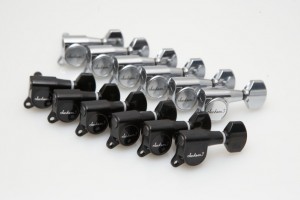 The first step was to remove the tuners. That’s an easy job and I’ve done it many times before. That’s when I came to my first issue. The tiny screws that came with the black tuners were smaller than the chrome ones. I decided to use the chrome screws until I could either source proper black screws or stop caring – whichever came first. The new tuners made an instant and dramatic difference to the look of the guitar, and I was very pleased with how it turned out. The next obvious step was to replace the nut.
The first step was to remove the tuners. That’s an easy job and I’ve done it many times before. That’s when I came to my first issue. The tiny screws that came with the black tuners were smaller than the chrome ones. I decided to use the chrome screws until I could either source proper black screws or stop caring – whichever came first. The new tuners made an instant and dramatic difference to the look of the guitar, and I was very pleased with how it turned out. The next obvious step was to replace the nut.
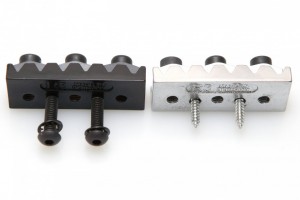 I’d never worked on a guitar nut before, but I figured a locking nut would be easy, so I forged ahead. The chrome nut came out with ease – two screws and it was out. I noticed that there were thin metal shims under the nut, which made me wonder if the new one would fit properly. I decided to leave them, thinking that there were likely more variations in wooden necks then there were in metal nuts. Then I discovered the next problem. The new nut had bolts screwed in from the bottom (like an Ibanez), while the old nut had wood screws from the top. The picture should tell the story pretty clearly. This freaked me out a bit since there was no way I was drilling holes into the neck of my Jackson! Then I realized that the holes in the chrome nut were threaded as well. The nuts were made to support both scenarios. Clever! Only problem was that I now needed to again use chrome screws on my black nut.
I’d never worked on a guitar nut before, but I figured a locking nut would be easy, so I forged ahead. The chrome nut came out with ease – two screws and it was out. I noticed that there were thin metal shims under the nut, which made me wonder if the new one would fit properly. I decided to leave them, thinking that there were likely more variations in wooden necks then there were in metal nuts. Then I discovered the next problem. The new nut had bolts screwed in from the bottom (like an Ibanez), while the old nut had wood screws from the top. The picture should tell the story pretty clearly. This freaked me out a bit since there was no way I was drilling holes into the neck of my Jackson! Then I realized that the holes in the chrome nut were threaded as well. The nuts were made to support both scenarios. Clever! Only problem was that I now needed to again use chrome screws on my black nut.
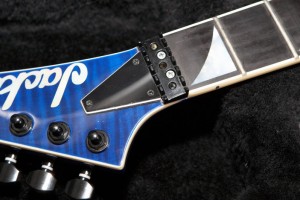 The chrome screws didn’t look to bad unless you removed the locks from the nut, and even then it wasn’t all bad. Would I have preferred black screws? Yeah. Was it a deal-breaker? No. With the locks on you don’t even see the screws unless I point them out to you, and even then it requires careful examination. I pushed my obsessive tenancies aside and continued with the upgrades. The easy stuff was done. I now had slightly more invasive work to do.
The chrome screws didn’t look to bad unless you removed the locks from the nut, and even then it wasn’t all bad. Would I have preferred black screws? Yeah. Was it a deal-breaker? No. With the locks on you don’t even see the screws unless I point them out to you, and even then it requires careful examination. I pushed my obsessive tenancies aside and continued with the upgrades. The easy stuff was done. I now had slightly more invasive work to do.
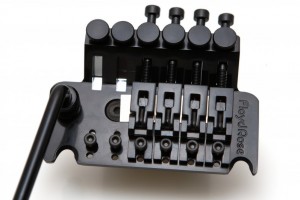 Next I decided to install the new Floyd Rose bridge. First I removed the old one, which was as simple as pulling off all the strings and lifting the bridge out of its hole. My first reaction was how much lighter the guitar became. There’s a lot of weight on that Floyd! I then got the black Floyd and proceeded to pull it apart in order to install the new brass block.
Next I decided to install the new Floyd Rose bridge. First I removed the old one, which was as simple as pulling off all the strings and lifting the bridge out of its hole. My first reaction was how much lighter the guitar became. There’s a lot of weight on that Floyd! I then got the black Floyd and proceeded to pull it apart in order to install the new brass block.
Installing a new block can be a daunting task if you’re not mechanically inclined. The entire bridge must be disassembled, which means if it was properly intonated, you’ll need to do that again. I noticed a shim under the four center saddles, presumably to allow the bridge to work well with smaller-radius fret boards. Since the USA Jackson has a nice flat board, I pulled it out. You can see it sticking out and covering the block bolt in the picture above. Since I had done this once before it wasn’t a very big deal. Having two German Floyd Rose bridges side by side, I decided to make some comparisons with the original block and the brass block.
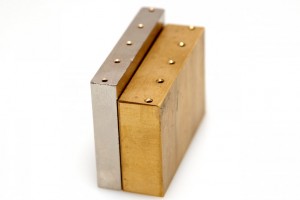 The first thing I noticed was that the block on the new Floyd Rose was longer than the one on the chrome bridge. Interesting, but irrelevant to the project at hand. After I pulled the original block off I took a side-by-side picture to illustrate the difference between them, which I’d say is significant. I did not have a means to weight these items, but I would say that the brass block alone weighed as much as the original block AND the Floyd rose bridge combined. It is, in fact, so heavy that when the project was done I needed to go from three springs to five in order to level the floating bridge. I love what these blocks do in terms of added sustain.
The first thing I noticed was that the block on the new Floyd Rose was longer than the one on the chrome bridge. Interesting, but irrelevant to the project at hand. After I pulled the original block off I took a side-by-side picture to illustrate the difference between them, which I’d say is significant. I did not have a means to weight these items, but I would say that the brass block alone weighed as much as the original block AND the Floyd rose bridge combined. It is, in fact, so heavy that when the project was done I needed to go from three springs to five in order to level the floating bridge. I love what these blocks do in terms of added sustain.
With the block installed I replaced the pivot posts with the black units, put the floyd in, added some springs and made sure that it still had freedom to move properly with the new block. It worked perfectly.
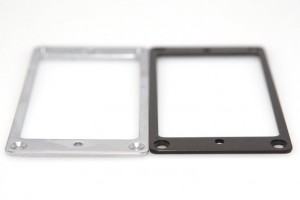 Though I didn’t yet have the pickups, I simply had to install the new rings to see how they looked. To my surprise, the $10 rings from guitarelectronics.com were a perfect match. I was really surprised to be honest, because I thought I’d never find metal rings that matched. Now the rings from fretsonthenet.com hadn’t come in yet, so I couldn’t say if they were even sexier, but I was very pleased with these rings. This picture shows the original USA Jackson ring next to the guitarelectronics.com ring.
Though I didn’t yet have the pickups, I simply had to install the new rings to see how they looked. To my surprise, the $10 rings from guitarelectronics.com were a perfect match. I was really surprised to be honest, because I thought I’d never find metal rings that matched. Now the rings from fretsonthenet.com hadn’t come in yet, so I couldn’t say if they were even sexier, but I was very pleased with these rings. This picture shows the original USA Jackson ring next to the guitarelectronics.com ring.
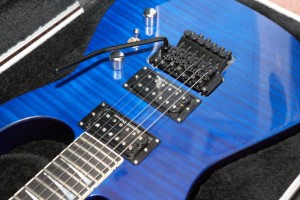 I pulled the Seymour Duncan pickups out and swapped rings. That’s when I discovered another problem, and again, it was the screws. I hadn’t thought to get black pickup ring screws, so I ended up installing the black rings with the black pickups using chrome screws. This problem wasn’t a “hidden under the nut locks” kind of problem. These screws are right out in the open for the world to see. Still, it didn’t look half bad. I briefly considered using the screws from the metal panels on the back of the guitar, but there are only seven. Missing a screw would be far more irritating to my obsessive brain than having eight chrome, but matching, screws.
I pulled the Seymour Duncan pickups out and swapped rings. That’s when I discovered another problem, and again, it was the screws. I hadn’t thought to get black pickup ring screws, so I ended up installing the black rings with the black pickups using chrome screws. This problem wasn’t a “hidden under the nut locks” kind of problem. These screws are right out in the open for the world to see. Still, it didn’t look half bad. I briefly considered using the screws from the metal panels on the back of the guitar, but there are only seven. Missing a screw would be far more irritating to my obsessive brain than having eight chrome, but matching, screws.
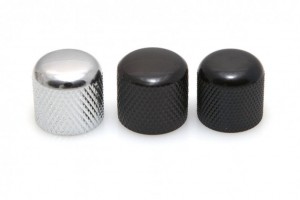 The knobs that I ordered from Warmoth looked great. They weren’t quite as large as the USA Jackson knobs, but they looked pretty darn close. The bigger problem though was that they didn’t fit on the pot shafts. Though they are set-screw knobs, they only fit on split-shaft pots. Much swearing ensued and the chrome knobs went back on. This problem would not resolve itself until the next day as you will soon read. Picured here are the USA Jackson chrome knob, the import Jackson black knob, and the Warmoth knob. The import Jackson knob did not fit on the USA solid-shaft pots either. Unable to make more progress, I went to bed.
The knobs that I ordered from Warmoth looked great. They weren’t quite as large as the USA Jackson knobs, but they looked pretty darn close. The bigger problem though was that they didn’t fit on the pot shafts. Though they are set-screw knobs, they only fit on split-shaft pots. Much swearing ensued and the chrome knobs went back on. This problem would not resolve itself until the next day as you will soon read. Picured here are the USA Jackson chrome knob, the import Jackson black knob, and the Warmoth knob. The import Jackson knob did not fit on the USA solid-shaft pots either. Unable to make more progress, I went to bed.
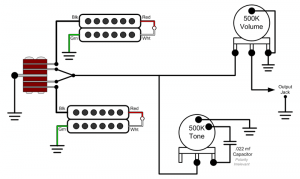 The next day my order from WCR showed up. It was solderin’ time! I started by carefully mapping out what was already there. The stock SL2H wiring is shown to the right. My drawing shows four-lead pickups, but each of the pickups in the Sl2H had only two-leads. I figure if I ever need to put in four-lead pickups without the coil-tap, this drawing will serve both purposes.
The next day my order from WCR showed up. It was solderin’ time! I started by carefully mapping out what was already there. The stock SL2H wiring is shown to the right. My drawing shows four-lead pickups, but each of the pickups in the Sl2H had only two-leads. I figure if I ever need to put in four-lead pickups without the coil-tap, this drawing will serve both purposes.
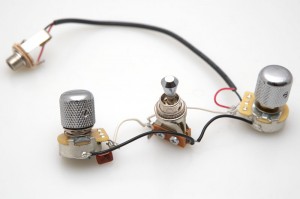 I removed the wiring harness intact so that I could return the guitar to its original state. This is something I do with every guitar I modify. No matter how much better I think I’ve made a guitar, it always seems to sell better stock if I decide to part with it. Oh, and for all you Jackson fans out there, no, you may not buy my chrome parts, switch tip, or complete wiring harness, pickups, rings or Floyd Rose. I feel your pain, I really do, but I’m keeping all the parts for the reasons already listed.
I removed the wiring harness intact so that I could return the guitar to its original state. This is something I do with every guitar I modify. No matter how much better I think I’ve made a guitar, it always seems to sell better stock if I decide to part with it. Oh, and for all you Jackson fans out there, no, you may not buy my chrome parts, switch tip, or complete wiring harness, pickups, rings or Floyd Rose. I feel your pain, I really do, but I’m keeping all the parts for the reasons already listed.
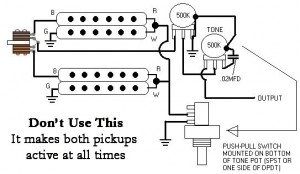 Since I wanted to add a coil tap for both pickups, I scoured the web until I found this drawing. Let me save you some heartache and some reading by simply saying, Don’t use it – it’s wrong! If you connect both sets of R/W wires from both pickups and then connect them to a single connection on the push/pull switch, then all pickups will be active at all times through at least one coil. That’s not quite what I was looking for. I can’t imagine anyone would want that, but who am I to judge?
Since I wanted to add a coil tap for both pickups, I scoured the web until I found this drawing. Let me save you some heartache and some reading by simply saying, Don’t use it – it’s wrong! If you connect both sets of R/W wires from both pickups and then connect them to a single connection on the push/pull switch, then all pickups will be active at all times through at least one coil. That’s not quite what I was looking for. I can’t imagine anyone would want that, but who am I to judge?
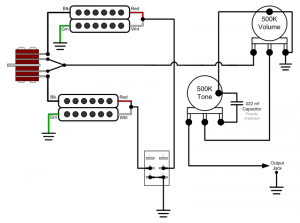 I altered the circuit a bit and now it works perfectly. You just need to put the red/white wires for each pickup on its own side of the push/pull pot. The grounds can be combined on the bottom pair of lugs, but the pickups each need their own center lug. Hopefully my drawing shows this better than I can explain it.
I altered the circuit a bit and now it works perfectly. You just need to put the red/white wires for each pickup on its own side of the push/pull pot. The grounds can be combined on the bottom pair of lugs, but the pickups each need their own center lug. Hopefully my drawing shows this better than I can explain it.
This is different than the stock wiring, but I don’t know enough about electronics to tell you if that’s good or bad. My first worry is that the switch is not grounded. So far no buzz, but I may add a ground in the future and update this page if needed. You may ask why I didn’t keep the original circuit, and that’s a great question. I figured I would try something new and see how it went. I’m nutty that way.
 Once I wired everything up, figured out what was wrong, rewired and tested, I put everything back together. That’s when I realized that the pots I received from WCR were not solid-shaft pots, so my Warmoth knobs worked after all. I could even swap the Jackson knobs from my import SL2H if I wanted to, since they used the same split shafts. With the knob crisis averted and everything working as it should, I plugged it in and played. The WCR American Steele pickups delivered as promised. All the meaty growl I wanted with the amazing articulation I’ve come to expect from Jim Wagner’s winds.
Once I wired everything up, figured out what was wrong, rewired and tested, I put everything back together. That’s when I realized that the pots I received from WCR were not solid-shaft pots, so my Warmoth knobs worked after all. I could even swap the Jackson knobs from my import SL2H if I wanted to, since they used the same split shafts. With the knob crisis averted and everything working as it should, I plugged it in and played. The WCR American Steele pickups delivered as promised. All the meaty growl I wanted with the amazing articulation I’ve come to expect from Jim Wagner’s winds.
The addition of the coil tap really makes this guitar more versatile, and I have to say, this is the best coil tap I’ve ever heard. With the selector in the middle and the pickups tapped, the guitar delivers a believable Strat position 2 sound. Does it sound as good as the Lindy Fralin Vintage Hots in my Strat? No, but it’s close enough for coil tapped humbuckers! I’m very happy I spent the time to add the feature.
I think the guitar looks much nicer with black hardware. The black rings with black bobbins seems to accentuate the space around the pickups, which is something I didn’t notice with the chrome. I measured the rings and they’re the same size, so it’s an optical effect and not a size problem.
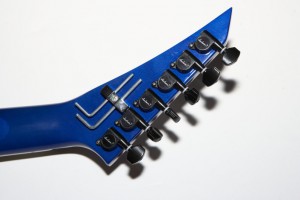 Overall the only parts that are still chrome are the tuning machine screws, the pickup ring screws, the jack plate (a black one is on its way), the Allen wrench clip on the back of the headstock, and the Allen wrenches. The switch tip is black plastic which looks fine, but I’m still on a quest to find a proper Jackson black metal tip or three.
Overall the only parts that are still chrome are the tuning machine screws, the pickup ring screws, the jack plate (a black one is on its way), the Allen wrench clip on the back of the headstock, and the Allen wrenches. The switch tip is black plastic which looks fine, but I’m still on a quest to find a proper Jackson black metal tip or three.
All in all, I’m quite pleased with the black hardware, love the coil tap, and just thrilled with the new pickups. I’m calling this one a success. Would I recommend this change for someone else? Maybe.
To accomplish the electronics change you need to be comfortable soldering, be able to follow a schematic, and be able to troubleshoot when it goes wrong. To do the cosmetic changes you need to be able to use an Allen wrench or two, a screwdriver and a wrench. If you upgrade the Floyd Rose block as I did, you’ll need to be able to put the Floyd back together after you take it apart. Of course you could just buy a different Jackson that already has black parts, or order one from the custom shop with your specs. For me, I’m a tinkerer, and I love to be able to play a guitar that I’ve modified to my specs.
In parting, I hope this page might help someone who is contemplating such a change. And finally, here are a pair of before and after pics for your enjoyment.
Donate: PayPal Crypto:
ETH: 0x0AC57f8e0A49dc06Ed4f7926d169342ec4FCd461
Doge: DFWpLqMr6QF67t4wRzvTtNd8UDwjGTQBGs


INSIGHTFUL article! Great external links! Nice mod!
After 27 years playing LPs, Strats and the occasional Parker, Godin, and Steinberger, I recently became the proud owner of 2 Jacksons (SL1 & 2H) as well as a 24-fret Custom Shop Charvel. I’m pretty much your identical twin by virtue of obsessiveness. This write-up just makes my up-coming jobs on the new stock axes much easier. THANKS!!!
PS: I enjoy your articulacy; your site’s bookmarked.
I love what you’ve done man! I’m considering buying a sl2-mah soloist. How much did it cost to buy all these parts? Installation? I love the blue, but I just don’t like the chrome as well.
Thanks,
Austin
Blue flamed Soloist is beautiful, and you have 2!! I am very much impressed and envy~~
Anyhow, since you have each from a different country. What other differences they have, sound aside?
How do the necks feel in comparison? Please let me know, I am ‘neck-profile’ conscious player.
Cheers & keep rocking.
ampz
Hi!
Nice job!
Anyway I just met the switch tip problem.
You can’t get a profile like your chrome .
(except the overpriced Charvel so-cal parts on ebay)
So I asked my friend and we make (some hundreds) in black (first), with CNC. 😀
hi, where did you buy the usa jackson black tuners???
Hi there – thanks for the comment. I bought them from someone on Ebay.
Hi Gad. Great write up. I have a question that maybe you could help me answer. I was wondering if you knew what the difference was with the tuners, from Japanese to US? I found the seller on ebay that you mentioned. He has a set of Jackson, made in Japan tuners. I have a made in japan charvel model6 (similar to a soloist) but want to put on the best tuners I can find, so I figured that those would be the ones made in the usa.
Anyway, I tried to contact the guy via ebay, but takes me to another site with a phone# and email. I tried both, email comes back bad and phone number doesn’t go through. Do you know of anyone else who sells Jackson parts and would you happen to have the part# of the ones you bought?
Thanks dude!
I’m not sure from a design or internals perspective. I’d imagine that the imports are not actually Gotohs, but I don’t know for sure. They’re very similar. I can tell you that I have an import Jackson SL2H that I’ve had for 10 years and the tuners are rock solid. With the double-lock trem the tuners only get used for initial stringing, so it’s not like they need to keep tune. I don’t know the part numbers, sorry. As for where to get them, I’d try an official Jackson dealer. That’s where I ended up getting the switch tip. Good luck!
gary i just started the process to change all the chrome hardware to black on my 2008 u.s.a. SL2H trans blue mah..so far i have the jackplate and the pickup rings,,,,,who was the jackson dealer you got the switch tip from.
i need one desprately….i think im going to put sperzel locking tuners on there but i have not made up my mind on that yet……i like the look of your guitar with the black so im doing the same….getting parts is a pain in the butt….
That was a fairly long time ago, but I got the tips through Richie’s Music in Rockaway, NJ. They just ordered them from Jackson at the time and IIRC they took a while to get. I’d imagine that any Jackson dealer should be able to do the same.
And yes, sourcing all of those parts was not easy. Good luck!
Gary, do you still have this guitar?
I do not. I returned it to chrome and sold it years ago. My go-to Soloist these days is a Soloist Professional Pro from the ’90s that I freaking love.
Fair enough. I was going to make you an offer. I’m looking for a trans blue SL2H but they’re becoming harder and harder to find. I just bought a trans black SL1 last month and am switching the chrome hardware out for black hardware. I don’t know why they put chrome on all the transparent finishes. It makes the guitars look really cheap, IMO. Parts have been fairly easy to find though. I really enjoyed reading your blog about this topic. I talked to a gentleman at Fender last week who said they are currently gathering a parts list to start selling Jackson USA parts in the near future. Not sure how accurate that is, but if it’s true, that makes me happy! Cheers!
I was wondering what year was your Jackson usa sl2 made??
Hey there. I no longer have it, but I want to say 2008ish. I’ve emailed Jackson with the S/N and will update if/when they respond.